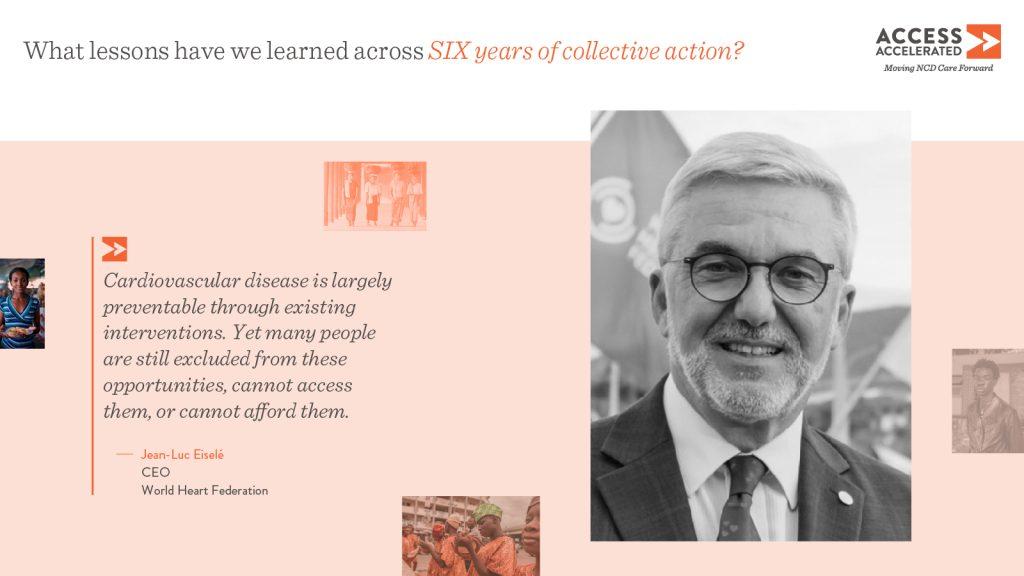Despite significant advances in science and evidence-based treatments, loss of life from cardiovascular disease (CVD) has doubled over the last two decades, with low- and middle-income countries (LMICs) shouldering most of this burden. Jean-Luc Eiselé, CEO of the World Heart Federation, explains the reasons behind this rise, the link between planetary health and cardiovascular health, and why reducing the CVD burden calls for an urgent mindset shift – from still-dominant siloed thinking to an inclusive, whole-of-society approach.

THE RISING INEQUITIES OF CARDIOVASCULAR DISEASE
Over 500 million people are living with CVD today, and more than 18 million people die from it each year, making it the world’s leading killer. And yet, cardiovascular disease is largely preventable. This means that the risk factors (excluding genetic conditions) are mainly linked to modifiable lifestyle behaviors, such as diet, alcohol, tobacco use and physical activity. In high-income countries, mortality rates from CVD have been decreasing due a greater understanding of these modifiable risk factors, improvements in medicine, and policy responses such as regulatory restrictions on food marketing, and taxes on tobacco and alcohol.
By contrast, CVD mortality is increasing in LMICs where cheap processed food, soft drinks, and tobacco are far more accessible than healthcare, diagnosis, and patient literacy. When you factor in comorbidities and the pressure of these on already-stretched healthcare systems, the growing burden in LMICs creates an alarming disparity.
But beyond geography, it is a question of equity as studies have shown an intrinsic link between level of education and life expectancy. Encouraging progress is being made in areas such as diagnostics, advanced imaging tools, and the use of digital health interventions. But the bottom line is that many people are still excluded from these opportunities, and either cannot access them or afford them. Until we close the gap which already affects vulnerable communities, cardiovascular disease will remain higher than it needs to be.
CREATING HEALTHY ENVIRONMENTS FOR CARDIOVASCULAR HEALTH
Cardiovascular health is embedded in a much broader context of societal, environmental, and commercial factors. Unless these interconnections are better understood, dealing with CVDs in isolation is likely to fail.
Elements such as climate change, the way we produce and consume food, the quality of the air we breathe and of the water we drink are all part of our vision of healthy hearts and a healthy planet. Half of the seven million deaths each year from air pollution, for example, involve heart disease and stroke.
The UN Sustainable Development Goals reflect the linkages among health, environment, education, and other factors. It is therefore imperative that we place cardiovascular health at the heart of health and climate policies.
REACHING THE HEARTS AND CHANGING THE MINDS OF POLICYMAKERS
The general sense of complacency about heart disease among the population must change and policymakers must pay attention. People seem to think that dying from cardiovascular disease is normal, and that one day your heart will simply stop – but that is simply not true. There is unnecessary suffering. CVD is not just painful for those who suffer from it and for their families, but for the economy and society. The evidence is there, the data is growing, and the mindset of people including policymakers is slowly changing. We have the knowledge and we know what to do so there is really no excuse not to act.
We need to commit financial resources, allocate them wisely and judiciously, track results and replicate them, and set and improve policies that are informed by what we are learning. The global goals of economic growth, and a lively, healthy population are interlinked, so we need to work in a more interdisciplinary way.
I remain optimistic that we can create change, but the time is now for all of us to act and implement what we know.
Jean-Luc Eiselé has worked in the field of medical association management for almost 20 years. He was trained as a biochemist working at the Biozentrum in Basel and the Pasteur Institute in Paris. He joined the World Heart Federation (WHF) as Chief Executive Officer in May 2017, strengthening the business model, the focus on communication and advocacy and membership engagement.
Read more interviews in the Access Accelerated report: Key Lessons in Advancing Access to NCD care.